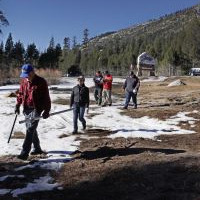Miserable Sierra Snowpack Ties a Record Low Set Way Back in 2012
 Frank Gehrke, chief of snow surveys for the Department of Water Resources, left, leads measuring group near Echo Summit (photo: Steve Yeater, Associated Press)
Frank Gehrke, chief of snow surveys for the Department of Water Resources, left, leads measuring group near Echo Summit (photo: Steve Yeater, Associated Press)
Whatever is responsible for this accursed good weather in the middle of winter—global warming, cyclical drought, bad luck or twisted karma—California will pay a heavy price if the Sierra Nevada snowpack stays at 20% of normal.
The first snow survey of the year by California’s Department of Water Resources (DWR) confirmed what everyone already knows: California is in the grips of drought, even if one has not been officially declared, and there is no sign of it ending soon. The state has already struggled through two parched years and a third looms unless something dramatic happens in the next few months.
The 20% average reading matched the lowest reading on record—in 2012. The worst readings were in the northern mountains, where snowpack is 11% and constitutes just 4% of what the normal average should be by April. The central Sierras were at 21% and 8%, respectively, and southern Sierras registered 30% and 10%.
Based on these measurements, the department projected that the State Water Project (SWP) will only be able to deliver 5% of the 4 million acre-feet of water requested for calendar year 2014 by 29 public agencies. Those agencies supply water to more than 25 million Californians and nearly a million acres of irrigated farmland.
Reservoirs throughout the state have a fraction of the water they usually have this time of year. Lake Oroville, the SWP’s key reservoir, and Shasta Lake, the fed’s largest reservoir, are at around 36% capacity, compared to their average of 57%. San Luis Reservoir is worse. The important reservoir south of the Delta is at 30%, compared to its average of 43%.
The state has been dry most everywhere this past year. One of the wettest places historically in California, the Gasquet Ranger Station in Del Norte County, wrapped up 2013 with 43.46 inches of rainfall, considerably less than its average 100 inches. Sacramento got 5.74 inches instead of its usual 18, and Los Angeles smashed its 1953 record-low rainfall of 4.08 inches by registering a miniscule 3.4.
California relies on Sierra Nevada snow for a third of its water, and is thinking about spending tens of billions of dollars to build tunnels to disperse more water that flows from the mountains to the rivers, to the Delta and beyond.
By some measures, calendar year 2013 was the worst on record for state rainfall. But meteorologists measure from October to October, so that official dubious record is still within range in the coming months. Around half of the state’s precipitation generally happens between December and the end of February.
One stormy winter could change it all, the professionals say. But even in the best of times, California’s annual rainfall is unpredictable. It broadly fluctuates in cyclical and noncyclical fashion. And with global warming introducing new variables and scrambling the old ones, these are not the best of times for weather and climate forecasting.
–Ken Broder
To Learn More:
Sunny Sierra Raises Chilling Drought Fears (by Peter Fimrite, San Francisco Chronicle)
Sierra Snow Less than a Quarter of Normal as California Dry Spell Lengthens (by Lisa M. Krieger, San Jose Mercury News)
Worst Sierra Snowpack in Five Years Threatens State Water Supplies (by Ken Broder, AllGov California)
Drought Information (California Department of Water Resources)
Snow Survey Finds Bare Ground, Little Snow (California Department of Water Resources) (pdf)
- Top Stories
- Controversies
- Where is the Money Going?
- California and the Nation
- Appointments and Resignations
- Unusual News
- Latest News
- California Forbids U.S. Immigration Agents from Pretending to be Police
- California Lawmakers Urged to Strip “Self-Dealing” Tax Board of Its Duties
- Big Oil’s Grip on California
- Santa Cruz Police See Homeland Security Betrayal in Use of Gang Roundup as Cover for Immigration Raid
- Oil Companies Face Deadline to Stop Polluting California Groundwater





